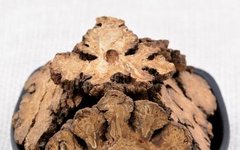Alias: Fu Xiong, Tai Xiong, Xi Xiong, Ma Xian, Guan Xiong, Jing Xiong
Overview: The Chinese medicinal herb Chuan Xiong (Ligusticum chuanxiong) is a blood-activating and stasis-resolving herb, derived from the dried rhizome of the Umbelliferae family plant.
Main Functions: Promotes blood circulation, moves Qi, dispels wind, and alleviates pain.
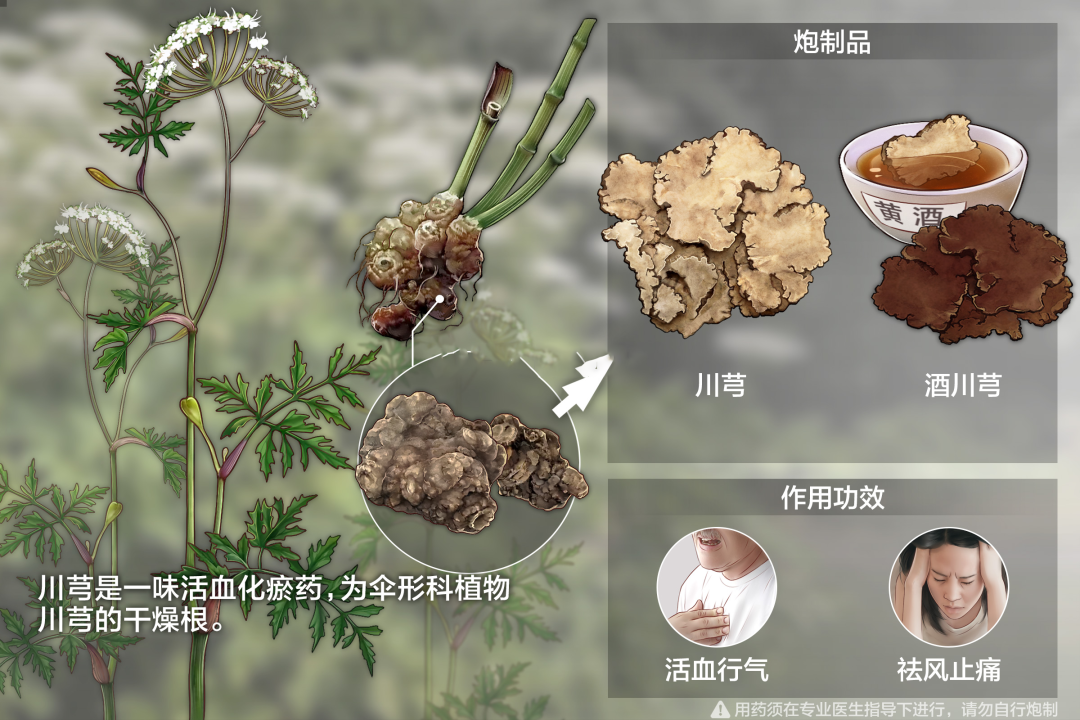
Typical Characteristics
Chuan Xiong is pungent and warm in nature. It enters the Liver, Gallbladder, and Pericardium meridians.
Chuan Xiong is aromatic and dispersing, entering the Liver, Gallbladder, and Pericardium meridians. It ascends to the head and descends to the blood sea, circulating blood and Qi internally while dispersing wind and cold externally. It has a strong blood-activating effect, treating various pains due to blood stasis and Qi stagnation, especially suitable for cold conditions, earning it the title of “Qi herb in the blood.” It is effective for various types of headaches, particularly those caused by wind-cold and blood stasis; it can also be used for wind-heat, wind-damp, and blood deficiency headaches, hence the saying, “Headaches do not part from Chuan Xiong.”
This herb contains alkaloids, volatile oils, phenolic compounds, lactones, as well as vitamins A, folic acid, sucrose, sterols, and fatty oils, which contribute to its effects of promoting blood circulation, moving Qi, dispelling wind, and alleviating pain.
Main Production Area
Primarily produced in Sichuan.
Medicinal Part of Chuan Xiong:
The dried rhizome of the Umbelliferae plant. Harvested in summer when the nodes on the stem are prominently protruding and slightly purplish, cleaned of soil, sun-dried, and then the fibrous roots are removed.
Characteristics of the Medicinal Part:
This product is irregularly nodular and fist-shaped, with a diameter of 2-7 cm. The surface is gray-brown or brown, rough and wrinkled, with many parallel raised nodes, a depressed round stem scar at the top, and numerous small tuberous root scars on the lower side and nodes.
It is solid and not easily broken, with a cross-section that is yellow-white or gray-yellow, scattered with yellow-brown oil chambers, and the growth rings appear wavy. It has a strong aromatic scent, a bitter and pungent taste, with a slight numbing sensation on the tongue and a mild sweetness.
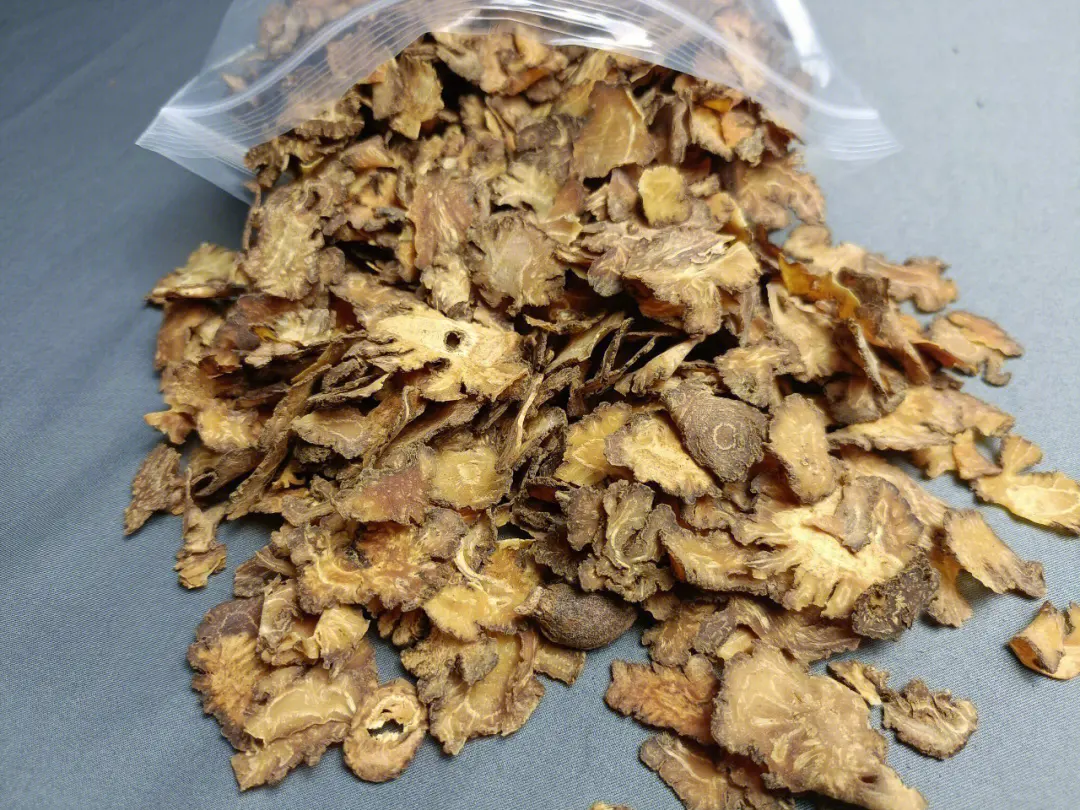
Literature Records
“Shennong’s Herbal Classic”: “Indicated for wind stroke entering the brain, headaches, cold bi syndrome, muscle spasms, traumatic injuries, and women’s blood stagnation leading to infertility.”
“Compendium of Materia Medica”: “Regulates various pulses, breaks up blood stasis… dispels stasis blood.”
“Supplement to the Materia Medica”: “This herb is most commonly used today, especially for wind in the head and face, but must be combined with other herbs.”
“Compendium of Materia Medica, Volume 14”: “A Qi herb in the blood, it alleviates Liver Qi stagnation, thus suitable for blood deficiency; it disperses with pungency, hence suitable for Qi stagnation.”
“Complete Works of Jingyue, Materia Medica”: “Chuan Xiong, its nature is good at dispersing, and it travels through the Liver meridian, a blood herb among Qi herbs.”
Actions and Effects
Chuan Xiong has the effects of promoting blood circulation, moving Qi, dispelling wind, and alleviating pain.
Indications
Chuan Xiong is used for chest bi syndrome, heart pain, stabbing pain in the chest and hypochondria, swelling and pain from falls, irregular menstruation, dysmenorrhea, abdominal pain from masses, headaches, and rheumatic pain.
Pain due to blood stasis and Qi stagnation
For Liver Qi stagnation and hypochondriac pain, often combined with Chai Hu (Bupleurum), Bai Shao (White Peony), and Xiang Fu (Cyperus);
For blood stasis causing amenorrhea and dysmenorrhea, often combined with Tao Ren (Peach Kernel), Hong Hua (Safflower), and Dang Gui (Angelica);
For postpartum lochia retention and abdominal pain due to stasis, often combined with Tao Ren, Dang Gui, and Pao Jiang (Dried Ginger);
For injuries from falls, stasis swelling and pain, can be combined with Ru Xiang (Frankincense), Mo Yao (Myrrh), and San Qi (Notoginseng).
Headaches and rheumatic pain
For wind-cold headaches, often combined with Bai Zhi (Angelica Dahurica), Xi Xin (Asarum), and Jing Jie (Schizonepeta);
For wind-damp headaches, often combined with Qiang Huo (Notopterygium), Fang Feng (Siler), and Gao Ben (Ligularia);
For wind-heat headaches, often combined with Ju Hua (Chrysanthemum), Shi Gao (Gypsum), and Jiang Can (Silkworm);
For blood stasis headaches, often combined with Tian Ma (Gastrodia);
For blood deficiency headaches, can be combined with Dang Gui, Shu Di Huang (Rehmannia), and Shao Yao (Peony);
For rheumatic pain, often combined with Du Huo (Angelica Pubescens), Qin Jiao (Gentiana), and Fang Feng.
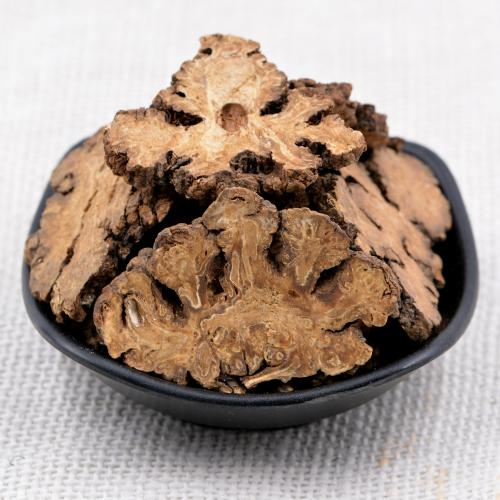
Modern Research
This herb has various pharmacological effects, including coronary artery dilation, increased coronary blood flow, reduced myocardial oxygen consumption, improved microcirculation, anti-cerebral ischemia, antipyretic, sedative, anti-tumor, anti-radiation, and immune regulation.
Usage Method
Chuan Xiong has the effects of promoting blood circulation, moving Qi, dispelling wind, and alleviating pain. It is often decocted for oral administration, but can also be used in porridge or soup. Regardless of the method, it should be taken according to a doctor’s instructions.
Preparation Method
Chuan Xiong
Take the raw herb, remove impurities, sort by size, and wash clean. Soak in water until the fingernail can penetrate the outer skin, remove, moisten thoroughly, slice thinly, and dry. Sift out debris.
Wine-processed Chuan Xiong
Take Chuan Xiong slices, mix with a specified amount of yellow wine, let it sit to absorb, and when the wine is fully absorbed, place in a frying container, heat gently until brown-yellow, then remove and cool. Sift out debris. For every 100 kg of Chuan Xiong slices, use 10 kg of yellow wine. This product contains volatile oils, so check during the soaking process to prevent oil degradation, and avoid high-temperature drying.
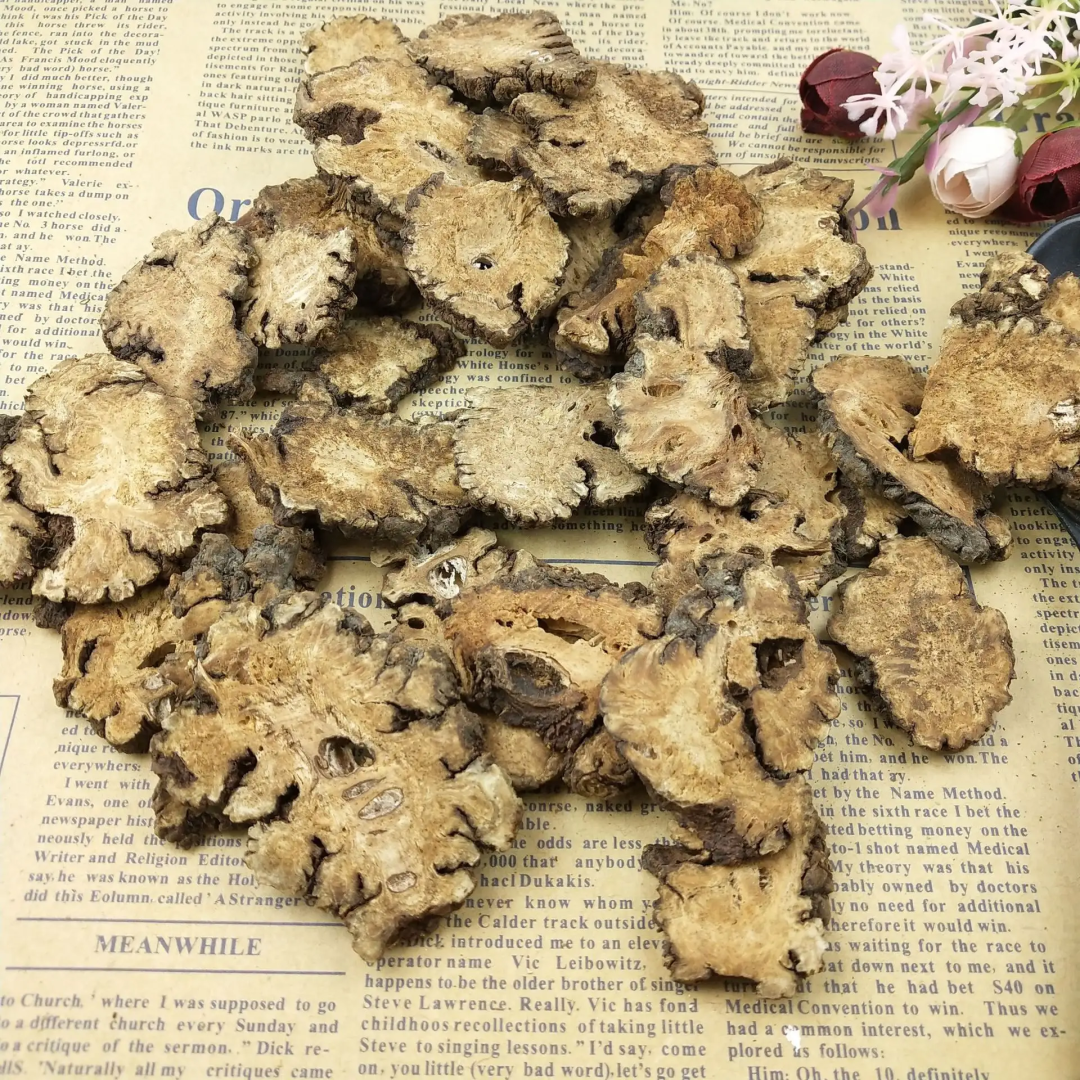
Compatibility and Contraindications
When using Chinese herbs in combination or with Western medicine, it is necessary to differentiate syndromes and provide individualized clinical treatment.
If you are using other medications, please consult your doctor before use and inform them of all diagnosed diseases and ongoing treatment plans.
Precautions
Chuan Xiong is pungent and warm, thus not suitable for those with Yin deficiency and excessive heat, Qi deficiency with profuse sweating, Qi counterflow with vomiting, excessive menstruation, and hemorrhagic diseases.
Attention
Those with Yin deficiency and excessive heat, as well as those with upper excess and lower deficiency or weak Qi should avoid it.
During medication, avoid cold, raw foods, and spicy, greasy foods.
Children should use this medication under the guidance of a doctor and adult supervision.
Please store the herbs properly and do not share your medication with others.
Medication Tips
Q Can pregnant women take Chuan Xiong?
A: No, they cannot. Chuan Xiong is a blood-activating and stasis-resolving herb, which promotes blood circulation and Qi. Its use can stimulate the uterus to some extent, especially in early pregnancy, increasing uterine tension and contractions. If taken in excess, it may cause abdominal pain and vaginal bleeding, leading to miscarriage and unavoidable harm, so pregnant women should not take Chuan Xiong.
Q
What are the effects and functions of Chuan Xiong Tea Tiao San?
A: Chuan Xiong Tea Tiao San is a traditional Chinese medicine formula composed of Chuan Xiong, Jing Jie (Schizonepeta), Bai Zhi (Angelica Dahurica), Qiang Huo (Notopterygium), Gan Cao (Licorice), Xi Xin (Asarum), Fang Feng (Siler), and Bo He (Mint). It has the effect of dispelling wind and alleviating pain, used for headaches caused by external wind invasion, or accompanied by chills, fever, and nasal congestion.
Q
What are the effects and functions of wine-processed Chuan Xiong?
A: Chuan Xiong is a blood-activating and stasis-resolving herb. After processing with wine, it can enhance its upward movement, increasing its effects of promoting blood circulation, moving Qi, and alleviating pain. It is often used for blood stasis headaches, chest and hypochondriac pain, irregular menstruation, and wind-cold-damp bi syndrome.
References
[1] National Pharmacopoeia Commission. Pharmacopoeia of the People’s Republic of China (Part One) [M]. Beijing: China Medical Science Press, 2020.
[2] Wang Jian, Zhang Bing. Clinical Chinese Medicine (2nd Edition) [M]. Beijing: People’s Health Publishing House, 2016.
[3] Zhou Zhenxiang, Tang Decai. Clinical Chinese Medicine (10th Edition) [M]. Beijing: China Traditional Chinese Medicine Press, 2016.
[4] Zhong Gansheng. Chinese Medicine (4th Edition) [M]. Beijing: China Traditional Chinese Medicine Press, 2016.
[5] Yan Zhenghua. Chinese Medicine (2nd Edition) [M]. Beijing: People’s Health Publishing House, 2006.
[6] Kang Yanguo. Chinese Medicine Identification [M]. Beijing: China Traditional Chinese Medicine Press, 2016.
[7] Xie Ming. Formula Science (3rd Edition) [M]. Beijing: People’s Health Publishing House, 2016.
[8] Tan Xinggui. Chinese Medicinal Cuisine [M]. Beijing: China Traditional Chinese Medicine Press, 2003.
[9] Xie Mengzhou, Zhu Tianmin. Chinese Medicinal Cuisine (3rd Edition) [M]. Beijing: China Traditional Chinese Medicine Press, 2016.
[10] Ye Dingjiang, Zhang Shicheng. Chinese Medicine Processing [M]. Beijing: People’s Health Publishing House, 1999.
[11] Gong Qianfeng. Chinese Medicine Processing (10th Edition) [M]. Beijing: China Traditional Chinese Medicine Press, 2016.
[12] Wu Hao, Li Fei. Chinese Medicine Processing (2nd Edition) [M]. Beijing: China Traditional Chinese Medicine Press, 2016.
Beijing Zhou’s Shizhen Hall Pharmaceutical Co., Ltd. was established in June 2008, focusing on the cultivation of medicinal materials, production of Chinese medicinal slices, research and development, sales, and traditional Chinese medical services.
Beijing Dongbitang Traditional Chinese Medicine Museum is dedicated to inheriting and promoting traditional Chinese medicine culture, carefully creating a comprehensive display of ancient Chinese medicine books, prescription manuscripts, tools, plaques, rare medicinal displays, medicinal specimens, and the reappearance of traditional Chinese medical treatment scenes, showcasing the characteristics of medical culture from different periods.

